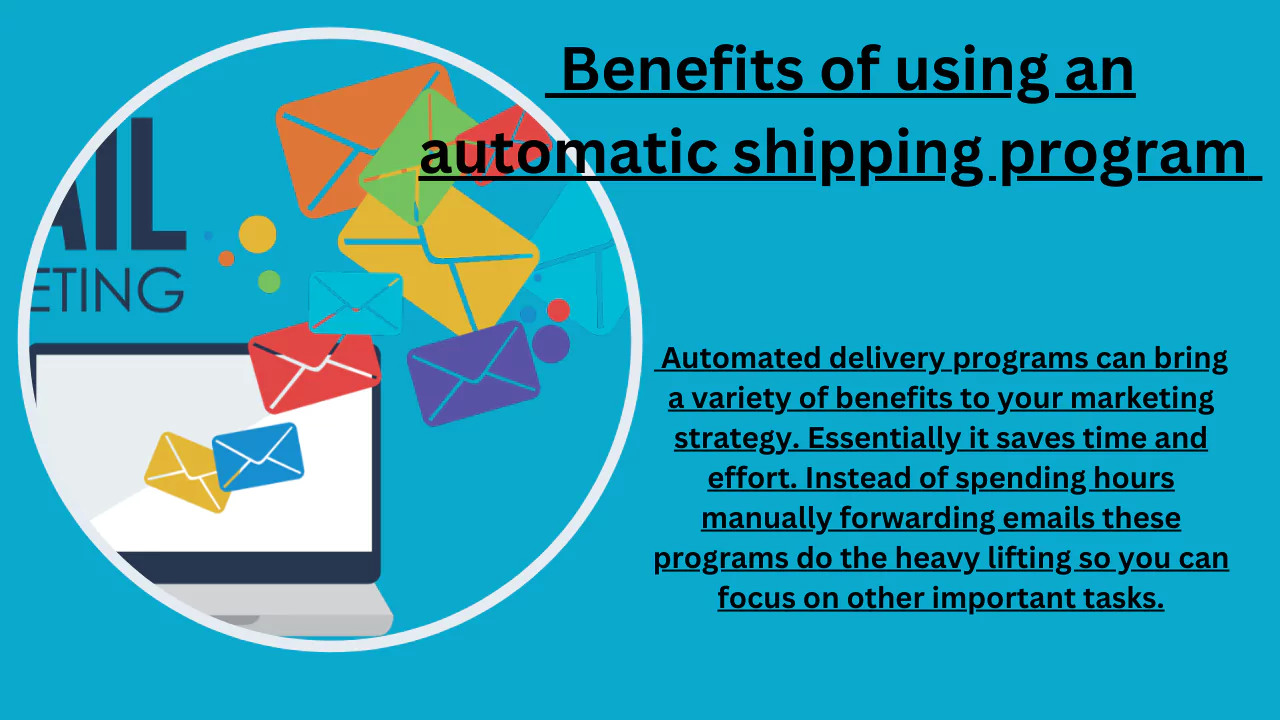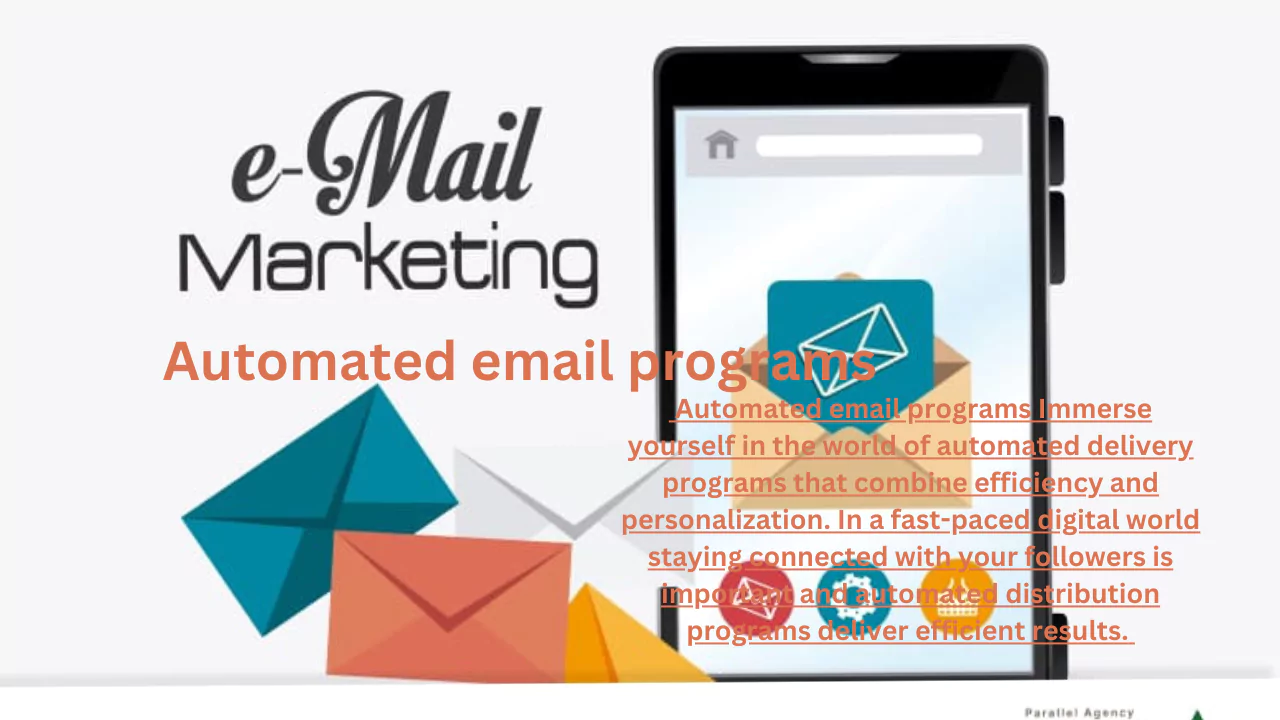Automated email programs Immerse yourself in the world of automated delivery programs that combine efficiency and personalization. In a fast-paced digital world staying connected with your followers is important and automated distribution programs deliver efficient results. Whether you’re a small business owner or a marketing professional this essay will show you how automated shipping programs can help increase engagement, drive transformation, and save you valuable time. Indicates whether
Benefits of using an automatic shipping program
Automated delivery programs can bring a variety of benefits to your marketing strategy. Essentially it saves time and effort. Instead of spending hours manually forwarding emails these programs do the heavy lifting so you can focus on other important tasks. In addition, automated delivery programs provide the ability to deliver content that is highly customized to each user’s preferences and activities.
From welcome emails to abandoned orphanages, these programs can be configured to send the right communications to the right people at the right time. Say goodbye to generic bulk emails and hello to meaningful contacts. 
Automated distribution programs can also help improve engagement rates. By combining the power of Slice Edge technology and intelligent segmentation you can deliver targeted programming to your subscribers at the right time. This personalization increases the applicability of your emails and increases open and click rates. Similarly, automated sending programs can help you nurture leads build connections with your followers and ultimately drive change and maximize profits. These programs allow you to take your subscribers through a customer journey and serve them relevant content based on their relationships and activities.
Auto shipping program types
There are many different types of auto-shipping programs that you can use in your marketing strategy.
1 Explore many popular bones
Drink Email The welcome email is the first communication your subscribers receive after signing up for your newsletter or making a purchase. It will set the tone for your relationship and provide an opportunity to make a positive impression. A welcome email can include a warm greeting an introduction about your brand and a special offer or invitation to encourage further interaction.
2 Abandoned Cart Emails ;Abandoned cart emails are forwarded to pharmacists who have added information to the online purchase form but have not completed the purchase. These emails act as reminders and incentives for guests to come back and complete their purchases. Encourage guests to complete the checkout process by including product images customer reviews and limited-time offers.
3 Re-engagement emails Re-engagement emails are forwarded to subscribers who have decreased engagement or become inactive. These emails ultimately pique interest and encourage subscribers to re-engage with your brand. Personalized offers exclusive content or interactive approaches can grab users’ attention and encourage them to take action.
4 Post-purchase emails: Post-purchase emails are forwarded to guests after they make a purchase. These emails give you an opportunity to thank your guest for their purchase ask for feedback and suggest related products or services. Including applicable upsell or cross-sell recommendations can help maximize customer retention value.
How to set up an automatic shipping program
Setting up an automatic shipping program requires careful planning and execution. Then you’re right here
1 Define your needs and easily define the goals you want to achieve with your automated delivery program. Considering your specific needs, whether it’s closing deals increasing customer loyalty, or driving your website business, can help you develop a strategy.
2 Member Followers Divide your subscribers into different parts based on demographics likes actions and purchase history. This segmentation allows you to include targeted programming that resonates with each group.
3 Create engaging content to create engaging shipping content that meets their needs and resonates with your followers. Drive engagement by using consistent language witty subject lines and clear calls to action.
4 Choose your delivery robotization platform. Choose the delivery robotization platform that meets your needs. Consider similar factors such as ease of use integration options, and reporting capabilities. Popular options include Mailchimp Active Campaign and HubSpot.
5 Configuring Alarms Define triggers to trigger automatic email sending. This may include actions such as subscribing to a newsletter making a purchase or canceling an order.
6 Design and Test Design visually appealing shipping templates that reflect your brand identity. Make sure your emails are mobile-friendly and optimized for a variety of senders. Test your emails with different email and shipping providers to make sure they display correctly.
7 Examiner and Optimize continuously monitor the performance of your automated shipping program. Analyze open rates click-through rates and conversion rates to identify areas for improvement. Test different subject lines content variations and delivery times to optimize your results.
Stylish practices to create an effective automated delivery giant
If you’re building an automated shipping giant stick to these stylish practices to maximize effectiveness.
1 Personalization Use dynamic tagging to target subscribers by name and flesh out your content based on their preferences. The more familiar your message is the more likely it is to resonate with philanthropists.
2 With a clear call to action, you can easily specify the action you want your philanthropist to take and highlight it clearly in your communications. Whether it’s to make a purchase, download a resource, or visit your website, a clear CTA will increase click-through rates.
3 Mobile Optimization With more and more people opening emails on mobile devices, it’s important to optimize your emails for mobile viewing. Check the responsiveness of your shipping template and test it on different screen sizes.
4 Run A/B tests to try different approaches to email. Test your subject lines and send content images and calls to action to find what resonates with your followers.
5 Avoid spam alerts. Familiarize yourself with spam detection words and phrases to ensure your emails are free of spam contaminants. Spam-checking tools can help you detect implicit problems before you send.
6 Robotization and Lethal Touch Automated dispatch programs save time, but it’s important to balance robotization and lethal touch. Incorporate special accents. B. Use a conversational tone and tweak your emails to make them seem more authentic.
Examples of Successful Automated Email Programs
To inspire your own automated email programs, let’s take a look at some successful examples:
- Spotify: Spotify’s personalized weekly playlists are a prime example of effective automated emails. Using data from user listening habits, Spotify curates a unique playlist for each subscriber, delivering it every Monday. This personalized approach keeps subscribers engaged and encourages them to continue using the platform.
- Amazon: Amazon’s abandoned cart emails are highly effective in recovering lost sales. They remind customers of the items left in their cart and often include customer reviews, related products, and limited-time discounts to entice customers to come back and complete their purchase.
- Airbnb: Airbnb sends personalized emails to both hosts and guests, providing recommendations based on their previous searches and bookings. These recommendations help drive engagement and encourage users to explore new destinations or book additional stays.
Common Challenges and How to Overcome Them
Implementing automated email programs may come with a few challenges, but with the right strategies, they can be easily overcome:
- Data Quality: Ensure the accuracy and quality of your data to avoid sending irrelevant or incorrect emails. Regularly clean your subscriber list, update contact information, and use double opt-in processes to maintain data accuracy.
- Integration Issues: When using an email automation platform, integration with other tools and systems can sometimes be challenging. Ensure that your chosen platform seamlessly integrates with your CRM, e-commerce platform, or other relevant systems to streamline data and workflows.
- Over-automation: While automation is powerful, it’s important not to overdo it. Bombarding subscribers with too many automated emails can lead to unsubscribes or disengagement. Strike a balance between automation and manual communication to maintain a personalized, human touch.
Tools and Software for Automating Email Programs
Several tools and software can assist you in automating your email programs. Here are a few popular ones:
- Mailchimp: Mailchimp is a user-friendly email marketing platform that offers automation features for businesses of all sizes. It provides a range of pre-built automation workflows and integrates with various other tools.
- Active Campaign: Active Campaign is a robust marketing automation platform that offers advanced features such as conditional logic, split testing, and dynamic content. It allows you to create highly personalized and targeted automated email campaigns.
- HubSpot: HubSpot is an all-in-one marketing platform that offers a suite of tools, including email automation. It provides a comprehensive solution for managing your contacts, creating workflows, and analyzing performance.
Tracking and Measuring the Success of Your Automated Email Campaigns
To measure the success of your automated email campaigns, you need to track relevant metrics. Here are a few key performance indicators (KPIs) to monitor:
- Open Rate: The percentage of recipients who open your emails. A higher open rate indicates that your subject lines and sender names are compelling.
- Click-Through Rate: The percentage of recipients who click on a link within your email. A higher click-through rate suggests that your content and calls-to-action are engaging.
- Conversion Rate: The percentage of recipients who complete a desired action, such as making a purchase or filling out a form. A higher conversion rate indicates that your emails are effective in driving the desired outcome.
- Bounce Rate: The percentage of emails that failed to deliver. A high bounce rate may indicate issues with your email list or email deliverability.
By analyzing these metrics, you can identify areas for improvement and optimize your automated email campaigns for better results.
Conclusion and Next Steps
Automated email programs offer a powerful way to engage your audience, drive conversions, and save valuable time. By leveraging the capabilities of these programs, you can deliver highly personalized content, nurture leads, and build meaningful connections with your subscribers. Remember to define your goals, segment your audience, craft engaging content, and continuously monitor and optimize your campaigns. With the right strategies and tools in place, you can take your email marketing to new heights and reap the rewards of automation.
